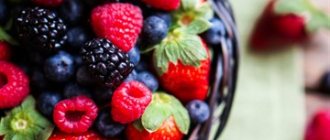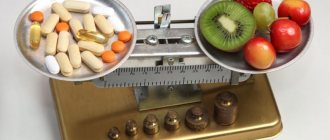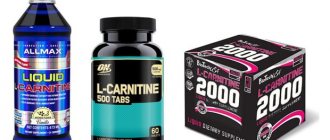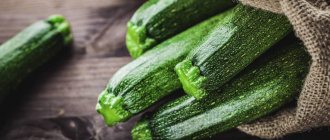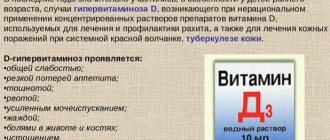What side effects are possible with a lack of vitamins A, B, C, D, E. How to take each of these elements correctly.
Throughout its existence, humanity has been in search of the elixir of eternal youth. People dream of living long, being healthy and beautiful. Unfortunately, there is no such miracle cure yet, but with the help of vitamins A, B, C, D, E it is possible to slow down the process of approaching old age and improve health.
It is important that useful elements arrive in a timely manner and in sufficient quantities. If there is a deficiency, the following side effects are possible:
- weakness;
- increased fatigue (mental and physical);
- deterioration of attention and memory;
- weakening of the immune system;
- increased irritability;
- slowing down the formation of new cells;
- problems with the formation of new teeth and bones.
This list of problems that a person faces in the event of a deficiency of nutrients is far from complete. In the article we will pay attention to the key elements for the body - vitamins A, B, C, D, E, which are involved in many vital processes and improve health.
Vitamin A (Retinol, Carotene)
Vitamin A or retinol. Vitamin A ensures the growth of the body and affects the maturation of epithelial cells, and is also part of the pigment of the retina. With a lack of vitamin A, twilight vision decreases.
Vitamin A is found in animal products. But, in the human body (in the liver and intestinal wall), vitamin A can be formed from substances called carotenes, which are found in plant foods.
There are different types of carotenes. But, β-carotenes (beta-carotenes) have the greatest ability to form vitamin A in the human body. In terms of effectiveness, 1.0 milligrams of β-carotene corresponds to 0.17 milligrams of vitamin A (i.e., 6 times lower). Therefore, the β-carotene content is converted to vitamin A (retinol) and expressed in retinol equivalent, like vitamin A.
An adult needs 1 milligram of vitamin A per day, calculated as the retinol equivalent. Typically, this need is provided by products of both animal and plant origin (due to the content of carotenes).
What foods contain vitamin A: Of animal products, the most vitamin A is found in fish oil (19 mg/100g), beef liver (8 mg/100g), pork liver and cod liver (4 mg/100g), less in eggs (0.4 mg/100g) and dairy products: in butter (0.4-0.5 mg/100g), milk (0.025 mg/100g).
In summer and autumn, due to the high content of β-carotene in fresh feed, its content in milk and butter increases significantly (up to several times). Therefore, milk and especially butter turn yellow, since β-carotene is a yellow pigment.
Among products of plant origin, the most β-carotene is found in red carrots (9 mg/100g), red peppers and green onions (2 mg/100g), apricots (1.6 mg/100g), pumpkin (1.5 mg/100g) ), tomatoes (1.0 mg/100g).
When foods are cooked, 20-40% of vitamin A is lost. The liver of an adult contains a reserve of vitamin A, so a pronounced lack of this vitamin in adults is quite rare.
Retinol
Vitamin A is a fat-soluble substance that naturally exists in two forms :
- Retinol is a ready-made vitamin A. It enters the body along with animal products.
- Carotene (provitamin A) is a substance that, after entering the blood, reacts with carotinase and is converted into retinol.
Action:
- Slowing down the aging process of the body, which is reflected in improving the condition of the skin and maintaining youth for a long time.
- Accelerating the growth of teeth, hair and bones, as well as ensuring their normal formation.
- Normalization of redox processes.
- Preventing the development of “night blindness” due to the presence of substances in the retina that provide visual functions. It is retinol that ensures rapid adaptation of the eyes to darkness.
- Strengthening the immune and cardiovascular systems.
- Increasing the amount of good cholesterol in the blood and reducing the risk of developing atherosclerosis.
- Increasing resistance to cancer and other diseases.
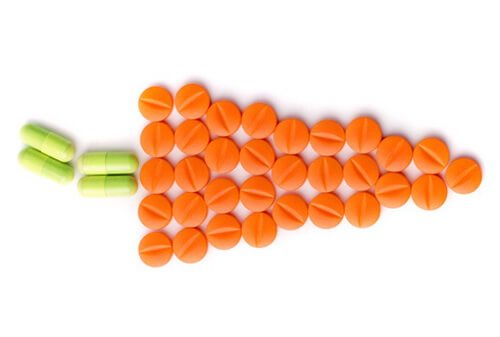
The main sign of deficiency is “night blindness,” which manifests itself as a sharp deterioration in vision with a sharp change in illumination. The eyes take longer to prepare for changes in light brightness. If the adaptation time to darkness exceeds 15-20 seconds , then it is recommended to consult a doctor for advice. During the intake process, it is important to avoid another risk - the toxic effect of an overdose.
Sources include parsley, carrots, spinach, tomato and peach. A large amount of retinol is found in green peas, rowan and sorrel. The diet should include apples, rose hips, red peppers, potatoes and green onions.
Interesting facts about carrots, which are a supplier of carotene:
- Studies have shown that regular intake of retinol in sufficient quantities reduces the risk of macular degeneration.
- The presence of carrots in the diet reduces the risk of developing malignant tumors of the colon and lungs. In addition, this product is a natural antiseptic that stops the development of infectious diseases. It is enough to apply a cut raw vegetable to the wound to stop the development of infection.
- According to scientists, people who eat 5-6 carrots a day suffer less from strokes.
The vitamin activity of carotene is three times lower when compared with retinol. For this reason, there should be three times more vitamin-containing plant-based foods in the diet than animal foods with retinol.
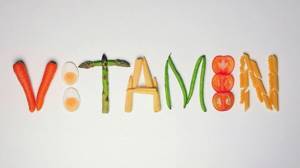
Vitamin B1 (Thiamin)
Vitamin B1 or thiamine. Thiamine is the name of the chemical formula of the substance. Vitamin B1 is part of enzymes involved in the digestive process to break down foods rich in carbohydrates. It also plays an important role in ensuring the normal functioning of the central and peripheral nervous system.
What foods contain vitamin B1: Vitamin B1 is found in legumes (peas - 0.8 mg/100g, beans - 0.5 mg/100g), in cereals (oatmeal - 0.5 mg/100g, millet - 0.4 mg/100g, buckwheat - 0.4 mg/100), pork (0.5-0.6 mg/100g), wheat bread made from 2nd grade flour (0.23 mg/100g), rye bread (0.18 mg /100g). A small amount of vitamin B1 is found in vegetables (0.02-0.10 mg/100g) and fruits (0.01-0.06 mg/100g), and in bread made from premium flour (0.10 mg/100g).
The content of vitamin B1 decreases by 20-40% when food is cooked. An adult needs about 1.7 milligrams of thiamine per day. The need for vitamin B1 is influenced by the composition of the diet. Foods rich in carbohydrates and alcoholic drinks increase the need for vitamin B1.
If the body lacks this vitamin, then disturbances in the functioning of the digestive and nervous systems occur: insomnia appears, increased irritability occurs, and a disturbance in the cardiovascular system (arterial hypotension) may occur.
In adults, thiamine deficiency is usually not observed. But, when eating foods rich in carbohydrates (sweet dishes, confectionery, etc.) and abusing alcoholic beverages, vitamin B1 deficiency may occur.
To eliminate thiamine deficiency, it is recommended to add legumes, various grains and wholemeal bread to your diet. You can also temporarily use vitamin preparations containing this vitamin.
It should be noted that excess vitamin B1 is also undesirable. In some people, an excess of the vitamin can cause allergic reactions (hives, mild chills, etc.). Most often they occur when vitamin injections are administered.
To prevent vitamin B1 deficiency, it is recommended to include black bread, cereals and legumes in the diet, not to abuse alcohol and limit the consumption of sweet and flour products.
Vitamins of group A: importance for athletes
Vitamins of group A
participate in the formation of bones, connective tissues and the functioning of the immune system. Retinoids play an important role in the formation of muscle tissue; they are extremely important for the production of protein, the destruction of which they also slow down, as well as for the formation of glycogen, a source of energy during physical activity. Testosterone synthesis is also directly dependent on vitamin A. That is why an athlete’s diet should be rich in this substance. However, you should not abuse vitamin A preparations due to their high toxicity in case of overdose. Including a sufficient amount of liver, eggs, butter and fish oil in the menu will adequately supply the athlete’s body with retinoids.
Vitamin B2 (Riboflavin)
Vitamin B2 or riboflavin. Vitamin B2 is involved in the formation of enzymes that play an important role in oxidation processes in body tissues. It is also involved in mechanisms regulating the metabolism of carbohydrates, proteins and fats. An adult needs 2 milligrams of vitamin B2 per day.
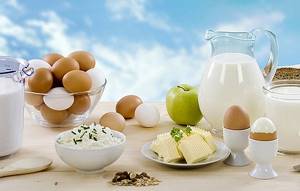
What foods contain vitamin B2: The need for riboflavin is fully satisfied through the consumption of bread, meat and dairy products. Vitamin B2 content in milk (0.15 mg/100g), cottage cheese (0.3 mg/100g), cheese (0.4 mg/100g), meat, fish, poultry (0.2 mg/100g), eggs ( 0.4 mg/100g). In plant foods, the highest content of riboflavin is in legumes (0.15 mg/100g) and wholemeal bread (0.1 mg/100g). Vegetables and fruits contain much less vitamin B2 (0.01-0.06 mg/100g).
Loss of vitamin B2 during heat treatment of products ranges from 10 to 30%. The lack of vitamin B2 in the human body is easily eliminated by correct selection of the diet and the inclusion of meat and dairy products.
B vitamins
From the “trinity” of vitamins A, B and E, scientists often isolate substances belonging to group B. Their benefits include a multifaceted effect on the body, namely strengthening the central nervous system, improving skin condition, and normalizing metabolic processes. The main representatives of this group include:
- Thiamine (B1) is a substance involved in the metabolism of carbohydrates, proteins and fats. Its intake normalizes the functioning of the gastrointestinal tract, central nervous system and cardiovascular system. Thiamine is also involved in improving blood circulation and removing toxins and poisonous substances from the body. Thiamine is often recommended for use to protect against the negative effects of cigarette smoke and alcohol. B1 has a positive effect on body growth, muscle tone and appetite.
- Riboflavin (B2) is an element that guarantees stable cell renewal. The substance is part of most enzymes and is involved in the breakdown of BZHU. Riboflavin is recommended for people whose activities involve frequent stress, as well as athletes for whom the formation of a sufficient amount of energy is key. Riboflavin is also involved in the conversion of carbohydrates into energy.
- Nicotinic acid (niacin, vitamin B3). Medicine has long classified this substance as a drug. Taking niacin guarantees normalization of blood cholesterol levels, reducing the risk of depression, and improving attention. The positive effect of nicotinic acid on joint mobility has been proven.
- Pantothenic acid a (B5) is a substance that quickly and effectively fights inflammation in the body. B5 is often taken for weight loss, participates in fat burning, and optimizes metabolic processes. Regular intake of the substance guarantees the production of a sufficient amount of energy, a positive effect on brain activity, protection against depression and forgetfulness.
- Pyridoxine (B6) is an element that plays a key role for athletes involved in strength sports. It participates in metabolic processes and regulates the process of protein absorption. The main thing is to combine B6 with B2, without which pyridoxine has 4 times less value. The supplement is involved in the creation of red blood cells, and in addition to protein, it is involved in fat and carbohydrate metabolism.
- Folic acid (B9) is a substance involved in the production of red blood cells. B9 improves the functioning of the gastrointestinal tract and liver, improves the activity of the nervous system and central nervous system. Taking folic acid improves mood, ensures better absorption of other vitamins and reduces the risk of heart problems. Folic acid is also important in preparation for childbirth and during pregnancy.
- Cyanocobalamin (B12) is an element that plays a key role in the restoration of the central nervous system, cell growth and hematopoiesis. The main sources of cyanocobalamin are products of animal origin (most of the substance is in the liver). The element is most useful for athletes who engage in strength sports and aim for rapid muscle growth.
Vitamin B5 (Pantothenic Acid)
Vitamin B5 or pantothenic acid. Pantothenic acid is found in enzymes involved in the metabolism of fatty acids and amino acids. It activates redox processes in the body, normalizes fat metabolism, and stimulates the production of adrenal hormones. An adult needs 5-10 milligrams of vitamin B5 per day. As a rule, this need is satisfied by the usual diet.
What foods contain vitamin B5: Vitamin B5 (pantothenic acid) is found in pressed baker's yeast (4-5 mg/100g), beef and pork liver (6-7 mg/100g), kidneys (3-4 mg/100g) , in smaller quantities – in meat (0.5-1.0 mg/100g), fish (0.3-0.8 mg/100g), legumes (1-2 mg/100g), milk (0.4 mg /100g). It is found in small quantities in vegetables and fruits (0.2-0.5 mg/100g).
It should be noted that during heat treatment of foods up to 50% of the vitamin is lost. A deficiency of pantothenic acid in the body is rare. It manifests itself in increased fatigue, lethargy, sleep disturbances, the body's resistance to infections decreases, and depressive states may occur. Pantothenic acid deficiency may be caused by a low protein diet, long-term use of antibiotics, and insufficient levels of vitamin C and B vitamins.
Vitamin B6 (Pyridoxine)
Vitamin B6 or pyridoxine. Vitamin B6 is contained in enzymes involved in the synthesis and metabolism of amino acids, unsaturated lipids and fatty acids. An adult needs 2 milligrams of vitamin B6 per day. With a lack of this vitamin, disturbances in the functioning of the nervous system are observed, problems arise with the condition of the skin, and dermatitis forms.
What foods contain vitamin B6: Large amounts of vitamin B6 are found in beans and soybeans (0.9 mg/100g) and meat products (0.3-0.4 mg/100g). Fish contains 0.2 mg/100g, vegetables and fruits (0.1-0.2 mg/100g). Vitamin B6 is partially formed in the human intestine as a result of the activity of microorganisms. Taking antibiotics has a negative effect on the vital activity of microorganisms and as a result, a lack of vitamin B6 in the body may occur. It is important to maintain good intestinal microflora and restore it after illnesses accompanied by the use of antibiotics.
Vitamin B9 (Folic Acid)
Vitamin B9, folic acid or folacin. Vitamin B9 is necessary for the formation of cells of the circulatory and immune systems, for the growth and division of bone marrow cells. An adult needs 200 micrograms of folic acid per day. The human liver is capable of storing folacin reserves, which can be used in case of insufficient Vitamin B9 intake from food for 2-6 months.
What foods contain vitamin B9: The main source of vitamin B9 in a normal diet is bread. Bread of different varieties contains vitamin B9 in amounts from 20 to 30 mcg/100g. Through daily consumption of bread (up to 500 grams), up to 50% of the need for this vitamin is satisfied. A lot of vitamin B9 is contained in pressed baker's yeast (up to 550 mcg/100g), a lot in beef and pork liver (230-240 mcg/100g), in green vegetables: parsley (110 mcg/100g), spinach (80 mcg/ 100g), lettuce (48 mcg/100g), onion (32 mcg/100g), fresh cabbage and green peas (20 mcg/100g). In cottage cheese (35-40 mcg/100g), cheeses (20-45 mcg/100g), milk (5 mcg/100g). There is relatively little vitamin B9 in fish and meat (5-9 mcg/100g). It should also be noted that folacin is quite sensitive to heat cooking.
Vitamin B12 (Cobalamin)
Vitamin B12 or cobalamin. Vitamin B12 is contained in enzymes involved in hematopoiesis, amino acid and nucleic acid metabolism reactions. A lack of vitamin in the body causes the development of anemia, dysfunction of the nervous system, weakness, dizziness, shortness of breath, and loss of appetite.
What foods contain vitamin B12: Vitamin B12 is found only in foods of animal origin. Plants do not form this vitamin, although they may contain the necessary amount of cobalt necessary for the synthesis of vitamin B12.
The most vitamin B12 is found in beef liver (60 mcg/100g) and kidneys (25 mcg/100g). It is found in smaller quantities in fish (1-3 µg/100g), beef (2.6 µg/100g), lamb (2 µg/100g), milk (0.4 µg/100g), cheeses (1-2 µg/ 100g).
An adult needs 3 micrograms of vitamin B12 per day. With a nutritious diet, there is usually no shortage of this vitamin. In addition, the human liver can maintain sufficient reserves of this vitamin to prevent deficiency for up to 1 year. But people who practice vegetarianism and exclude animal products from their diet may lack vitamin B12, which can lead to undesirable consequences. This especially applies to children whose diet excludes animal products. Everyone should consume them in reasonable quantities.
It is known that vitamin B12 combines in the stomach with the intrinsic factor of Castle (a special protein substance produced by the gastric mucosa) and only after that is it absorbed by the body. Impaired formation of intrinsic factor Castle (occurring in some diseases) also leads to hypovitaminosis B12, despite the fact that food contains a sufficient amount of this vitamin.
Vitamins of group A: the history of discovery
Group A vitamins became known to mankind at the beginning of the twentieth century, when the scientific community was just learning about the properties of vitamins and their biological role. Back in the 19th century, the Russian researcher N.I. Lunin, as a result of his experiments, came to the conclusion about the presence of vital substances in food, but not yet known to science. He fed laboratory mice all the artificially combined food elements recorded at that time by science. However, proteins, fats and carbohydrates were not enough - the animals got sick and died. Already in 1913, parallel experiments on rodents at two European universities at once confirmed that Lunin was right: an artificial combination of seemingly all the necessary components led to eye disease, gastrointestinal disorder and death after a couple of months; mice could only survive by eating natural foods. The scientists’ conclusion was unequivocal: there are also certain substances in natural food, which one of the researchers, E. McCollum, designated as “fat-soluble factor A” and “water-soluble factor B.” In 1931, the structure of vitamin A was determined, and in 1937 it was synthesized. The name “retinol” is due to the importance that this substance has for the retina - the retina. Since ancient times, an eye disease has been known - night blindness, which, not yet knowing about the existence of vitamins, was associated with poor nutrition and was correctly treated - in particular, with beef liver.
Vitamin C (Ascorbic acid)
Vitamin C or ascorbic acid. Vitamin C normalizes the functioning of the central nervous system, increases a person’s resistance to negative external factors, promotes the absorption of iron and the formation of blood cells, and stimulates the activity of the endocrine glands. Vitamin C is not synthesized in the human body. All the required amount of vitamin C comes from food, mainly fruits, vegetables and berries.
What foods contain vitamin C: The most vitamin C is found in fresh rose hips (up to 2000 mg/100g), red sweet pepper (250 mg/100g), sea buckthorn and black currants (200 mg/100g), less in cabbage and spinach (50-70 mg/100g), strawberries, white and red currants, oranges, tangerines, lemons (40-60 mg/100g), green peas, green onions, new potatoes (20-30 mg/100g).
Vitamin C is one of the most unstable vitamins. Its content in berries, fruits and vegetables quickly decreases during storage (except for sauerkraut and fresh cabbage). After 3-4 months of storage, vitamin C is half destroyed. It is also destroyed during heat treatment of foods - boiling or frying. In this case, its losses range from 30 to 80%. The longer foods are cooked, the greater the loss of vitamin C. For example, when cooking vegetables immersed in cold water, 30 to 50% of the vitamin is lost; when immersed in hot water, 25 to 30% is lost. Therefore, to preserve vitamin C, vegetables should be immersed in boiling water for cooking. Vitamin C losses are significantly reduced when vegetables are cooked with their skins on. For example, potatoes, carrots or beets before preparing salads.
An adult needs 70 mg of vitamin C per day. If food contains insufficient amounts of vitamin C, a person quickly gets tired, mental and physical activity and performance decrease, immunity and the body’s resistance to various infections decrease.
To eliminate seasonal vitamin C deficiency (winter and spring), it is recommended to use fresh and sauerkraut . Despite the fact that when cabbage is sauerkraut, some of the vitamin C is lost, it is still quite sufficient (30-40 mg/100g). Other products, such as apples and potatoes, contain much less vitamin C. If your intake of vitamin C from foods is insufficient, you can use vitamin C granules in combination with other vitamins and microelements. Vitamin C intake per day is no more than 100 mg for an adult. Taking large doses of ascorbic acid (more than 1 gram) daily can be harmful to your health. In this case, the body is forced to destroy excess vitamin C and remove the breakdown product, oxalic acid, with urine. Taking large amounts of vitamin C can promote the formation of kidney stones due to the accumulation of oxalic acid in them. Also, excess vitamin C can cause insomnia, headaches and even bleeding - as a result of increased capillary fragility.
If vitamin C has been taken in large doses for a long time, it is necessary to carefully reduce the intake of the vitamin to the standard level, due to the fact that hypovitaminosis may occur, as the body gets used to destroying and eliminating excess vitamin in large quantities.
Vitamin D (Calciferol)
Vitamin D or calciferol. Vitamin D regulates phosphorus-calcium metabolism in the human body. Vitamin D includes compounds that are similar in chemical structure. These are ergocalciferol - D2 and cholecalciferol - D3.

Vitamin D activates calcium in the small intestine, promotes its absorption and bone mineralization. The main amount of vitamin D is formed in the human body in the skin layer under the influence of ultraviolet rays. The effect is on provitamin D (7-dehydrocholesterol), which is formed from cholesterol in the deeper layers of the skin. Part of vitamin D comes from food.
What foods contain vitamin D: Plant-based foods do not contain vitamin D. In animal products, a lot of vitamin D is found in some fish products: cod liver (100 micrograms/100g), Atlantic herring (30 micrograms/100g). Vitamin D is also found in eggs (4.7 micrograms/100g), beef liver (2.5 micrograms/100g), butter (1.5 micrograms/100g), milk (0.05 micrograms/100g).
An adult needs 2.5 micrograms of vitamin D per day (calculated as D3). The liver of an adult can accumulate a significant amount of vitamin D, sufficient to meet its needs for 1 year. However, people who don't get enough sun exposure and ultraviolet rays may become deficient in vitamin D.
Vitamin D is especially necessary for children, as it plays an important role in the formation of the bone skeleton. Lack of vitamin D leads to disturbances in phosphorus-calcium metabolism. The responsibility here lies primarily with parents who create conditions in which children do not receive enough sunlight and ultraviolet rays that contribute to the formation of vitamin D.
Parents need to be aware that consuming vitamin D in large quantities can have severe toxic effects. It is not recommended to give children vitamin D supplements on their own. Its overdose leads to an increase in the level of calcium in the blood, calcification of the kidneys and heart and can have tragic consequences. Additional vitamin D intake is carried out only on the recommendation of a doctor and under his supervision.
Vitamin D
Vitamins A, D, E are reliable helpers in improving metabolic processes and maintaining youthful skin. One of the main functions is performed by vitamin D. In medicine, this drug is known as the main medicine in the treatment of rickets. The main feature of D is that it comes only from food and is not able to be synthesized by the human body. The main source of the useful element is the sun's rays.
Regular sunbathing eliminates deficiency. In this case, the following conditions must be taken into account
- It is best to sunbathe in the morning, immediately after sunrise, or in the evening, when the sun's disk has set below the horizon. During this period, vitamin production occurs most actively.
- People with fair skin produce more of the beneficial substance.
- Gradual aging of the body leads to deterioration in digestibility.
- Dust, gas pollution and emissions from enterprises eliminate the negative effects of sunlight.
It is worth considering that sunbathing should be taken in moderation while simultaneously taking in beneficial elements. Thus, vitamins A, E, D in special supplements reduce the carcinogenic effect of sunlight and protect the skin. contribute to the formation of vitamin D :
- water baths;
- massage;
- air baths.
All this guarantees a high-quality massage, which accelerates cell renewal and normalizes the functioning of the glands.
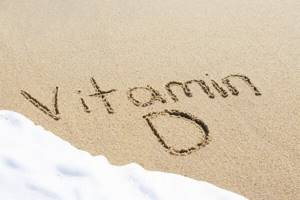
Effect on the body:
- Helps the body absorb calcium, which improves the formation of teeth and bones.
- Participation in the regulation of cell reproduction.
- Strengthening muscle fibers and normalizing metabolic processes.
- Increasing the body's resistance to heart and vascular diseases.
For greater effect and to ensure better absorption, simultaneous intake of vitamin D and E is recommended .
Insufficient vitamin D intake increases the risk of developing the following diseases:
- arthritis;
- diabetes;
- atherosclerosis.
When exposed to the sun for 15-20 minutes a day, the body receives half the daily requirement. The dosage largely depends on the level of physical activity, age, physical condition and a number of other factors. When taking vitamin complexes, it is recommended to control the dosage, because increased consumption of the substance over a long period leads to similar effects (one of them is softening of bones).
The main sources of the substance are butter, milk, meat and egg yolk. It is recommended to include other foods in the diet, including sour cream, tuna, mackerel and herring.

Vitamin E (Tocopherol)
Vitamin E or tocopherol. Vitamin E is involved in cellular respiration, promotes the absorption of proteins and fats, and affects the functioning of the sex and some other glands. Vitamin E is necessary to maintain youthful skin, accelerates wound healing, prevents the formation of blood clots in blood vessels and promotes their resorption.
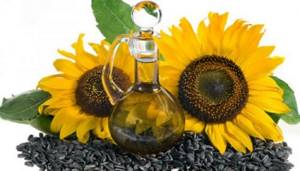
There are several isomers of tocopherol (α, β, γ, etc.). All of them exhibit not only the biologically active properties of vitamins, but also antioxidant properties - incl. inhibit the oxidation of unsaturated lipids.
An adult needs 10 milligrams of vitamin E per day, calculated as α-tocopherol. α-tocopherol is the most active isomer.
What foods contain vitamin E: Tocopherols are widely distributed in plant foods. The most tocopherols are found in vegetable oils: soybean (114 mg/100g), cottonseed (99 mg/100g), sunflower (67 mg/100g). Incl. α-tocopherol content in sunflower oil (64 mg/100g), cottonseed oil (50 mg/100g), soybean oil – total (10mg/100g).
Vitamin E is found in smaller quantities in almost all staple foods: different types of bread (2-4 mg/100g), cereals (2-9 mg/100g), in meat on average (0.7 mg/100g, incl. including α-tocopherol - up to 0.4 mg/100g), in cow's milk (up to 0.1 mg/100g, including α-tocopherol - up to 0.04 mg/100g). Content of α-tocopherol in vegetables and fruits (0.1-0.6 mg/100g).
Due to the presence of tocopherols in a wide range of foods, vitamin E deficiency in the human body is rarely observed, mainly after illness. It is not recommended to overuse vitamin E in large quantities, because the removal of calcium from bones is accelerated.
Vitamin A interactions
With long-term use of vitamin A, it is necessary to take vitamin E at the same time, because its deficiency interferes with the absorption of vitamin A. The conversion of vitamin A into its active form is promoted by zinc, so zinc deficiency leads to impaired absorption of vitamin A. There is evidence of a negative interaction of carotene with alcohol: when they are combined, liver damage is possible to a greater extent than when taken alone alcohol, this must be taken into account with frequent and significant use of alcohol-containing drugs. When taking cholesterol-lowering drugs, it must be taken into account that they may interfere with the absorption of fats and fat-soluble vitamins, so vitamin A should be taken at different times with hyperlipidemic drugs. Vitamin A should not be prescribed simultaneously with retinoids, because their combination is toxic. When taking laxatives of mineral origin, the absorption of fat-soluble vitamins is impaired, incl. vitamin A.
Vitamin PP (Niacin)
Vitamin PP or niacin. Vitamin PP is involved in redox reactions in the cells of the body, regulation of higher nervous activity, and protein metabolism. An adult needs about 19 milligrams of niacin per day.
What foods contain vitamin PP: Vitamin PP is found in products of animal origin: poultry (6-8 mg/100g), beef (5 mg/100g), lamb (4 mg/100g), pork (3mg/100g), liver (9-12mg/100g). Vitamin PP is also found in products of plant origin, but in difficult-to-digest forms: in wholemeal wheat bread (3 mg/100g), buckwheat (4 mg/100g), legumes (2 mg/100g).
Compared to other vitamins, niacin is more resistant to heat cooking - within 15-20% of the vitamin is destroyed. A deficiency of vitamin PP can occur in people whose diet does not contain meat products, and whose diet mainly consists of grain products. With acute chronic deficiency of vitamin PP, pellagra develops, a disease manifested in skin lesions. The reason is that grain products contain niacin mainly in a bound form, which is not absorbed by the human body. The bound form of niacin is absent in animal products and legumes.
To exclude hypovitaminosis PP, it is recommended to include more meat products in the diet during the period when the need for the vitamin increases sharply (especially in spring). The essential amino acid tryptophan, which is part of animal proteins, can be used by the body to synthesize vitamin PP. It takes 60 milligrams of tryptophan to form 1 milligram of niacin. Therefore, including high-protein foods in your daily diet can compensate for the lack of this vitamin in other foods. Taking this feature into account, the content of vitamin PP in food products can be expressed in “niacin equivalent”, taking into account the tryptophan content.
When recalculating the vitamin value of products taking into account the tryptophan content, it turns out: milk contains vitamin PP (0.10 mg/100g), tryptophan (50 mg/100g), the final niacin equivalent is narrower (0.94 mg/100g); beef contains vitamin PP (4.7 mg/100g), tryptophan (210 mg/100g), niacin equivalent (8.2 mg/100g); eggs contain vitamin PP (0.19 mg/100g), tryptophan (204 mg/100g), niacin equivalent (3.6 mg/100g).
Vitamin A dosages
Vitamin A preparations are prescribed orally, intramuscularly and externally (locally). Vitamin A is used in preventive and therapeutic doses. Prophylactic doses are set based on the daily need of the human body for vitamins. The use of vitamin A for medicinal purposes should be strictly under the supervision of a physician. Therapeutic doses of vitamin A for mild and moderate avitaminosis are 33,000 IU (0.01 g) per day for adults; children - 1000-5000 ME per day. For skin diseases, adults - 50,000-100,000 ME, children - 5,000-10,000 ME per day. Single doses of vitamin A should not exceed 50,000 IU for adults and 5,000 IU for children, daily doses - 100,000 IU for adults and 20,000 IU for children. The preventive daily dose of vitamin A for an adult is 3300 IU. During pregnancy, it is not recommended to take more than 6000 IU of vitamin A per day, because in large doses it has a teratogenic effect, i.e. can lead to congenital deformities in children. A toxic effect is observed at dosages above 25,000 IU per day. Pregnant women should not consume fish oil. When planning pregnancy, it is also necessary to take into account that retinol accumulates in the body, and if a woman has been treated with high doses of vitamin A, then it is better to plan pregnancy no earlier than 6 months after stopping taking retinol. Children should not take more than 18,000 IU of vitamin A per day for a month.

